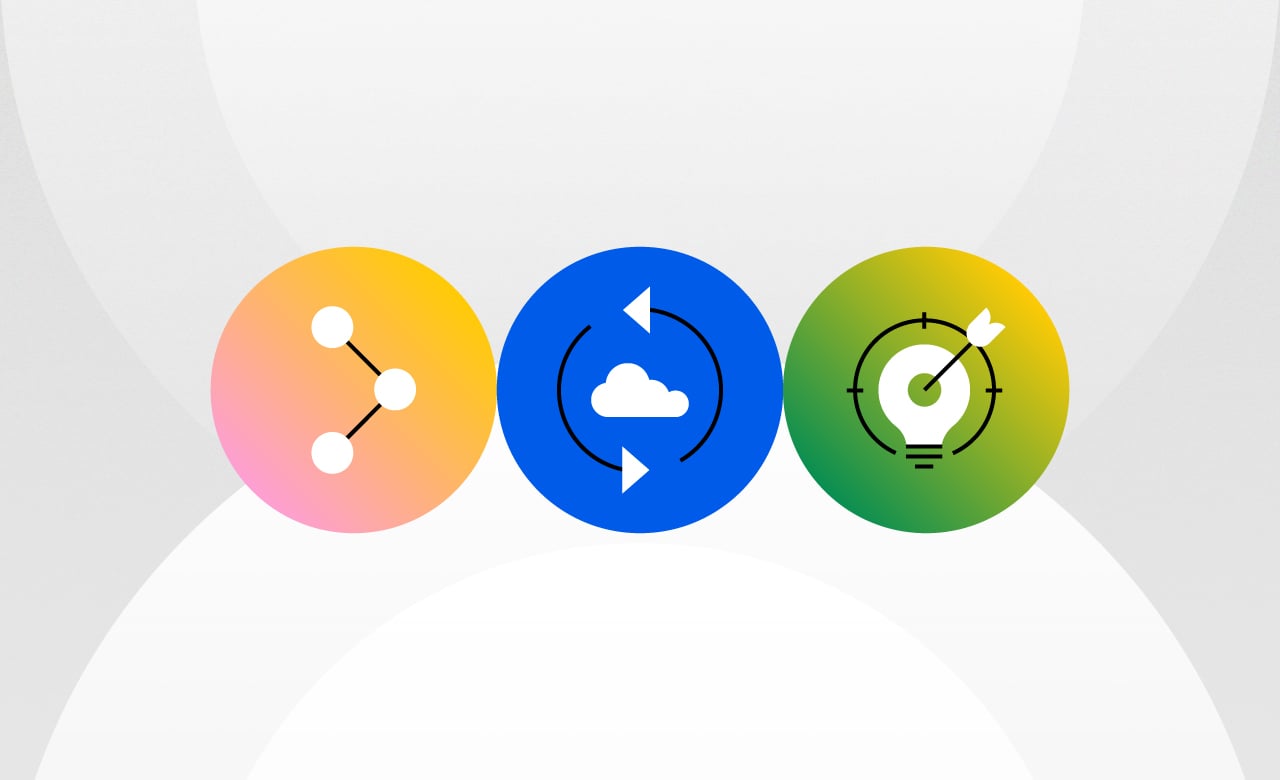Panzura Symphony Knowledge Edition Powered by MetadataHub: Finding the Answers Hidden in Your Files
You’re Not Data Poor—You’re Insight Poor
Panzura
Our enterprise data success framework allows enterprises to build extraordinary hybrid cloud file and data systems.
![]()
Platforms
Complementary file and data platforms that deliver complete visibility, control, resilience, and immediacy to organizations worldwide.
Solutions
From data resilience to global file delivery, we solve the toughest and most important data problems facing organizations globally.
Resources
Find insights, news, whitepapers, webinars, and solutions in our resource center.
Company
We bring command and control, resiliency, and immediacy to the world’s unstructured data. We make it visible, safeguard it against damage, and deliver it instantly to people, workloads, and processes, no matter where they are.
10 min read
 Nick Prill
:
Jul 24, 2025
Nick Prill
:
Jul 24, 2025

Table of Contents
Moving Beyond the Illusion of Simplicity to Understand Where True Control and TCO Resides for Your Hybrid and Multi-Cloud Files
Key Takeaways:
Many technologists have been captivated by fully managed content solutions for file management. However, it’s a mirage to believe you’ve achieved file management nirvana where your files are actually controlled by an unseen hand.
As seasoned storage admins, sysadmins, and IT directors well know, the devil is in the details. A deeper look at these types of solutions often reveals a critical vulnerability. It comes down to the inherent architectural limitations of third-party-managed file solutions that potentially compromise your data autonomy and increase your overall Total Cost of Ownership (TCO).
Take a look at the realities of relying on third-party infrastructure for your core files. We invite you to re-evaluate who truly controls your file data and consider how Panzura CloudFS stands apart by putting you firmly in control, while maintaining a cloud-first posture and delivering hard-to-beat cost efficiency.
Fully managed solutions like Egnyte simplify file access and collaboration by abstracting away the underlying infrastructure. This can be great for basic file sharing like SharePoint. However, this simplification possibly comes at the cost of granular control over your data and can possibly lead to hidden, escalating costs.
Let’s start with encryption key management, which is a crucial aspect of control. When you store data with a third-party provider, who manages the encryption keys? While it’s true that some, often higher-tier, managed service providers now offer the use of industry-standard key management solutions that ensure that keys are in control of the customer, not the service provider, the default for many fully managed solutions, including Egnyte, is that their encryption keys are managed by the vendor.
This means you must trust a third party with the ultimate control over access to your sensitive data. Even if advanced options like Enterprise Key Management (EKM) are available from some SaaS vendors, these are typically an opt-in feature for higher tiers, adding complexity and not representing the fundamental, “by design” architectural approach to data sovereignty. If you cannot directly manage your own keys, you inherently lose a layer of data sovereignty and direct oversight.
Going deeper, there are other aspects of control that you need to think about:
For example, users often discover that some providers primarily leverage a specific cloud for core infrastructure. This can lead to vendor lock in, limiting your flexibility to choose the cloud provider that best fits your needs, pricing models, or geographic requirements. It restricts your ability to diversify your cloud strategy or negotiate better rates with other providers, which can directly impact your cloud spend.
While Egnyte offers various integrations, directly feeding datasets from their proprietary system into a hyperscaler’s native AI and ML services can be complex and potentially incurs significant egress fees, as your data might need to be moved out of their managed environment. This can slow down innovation and inflate costs if you’re forced to move data or rely on a vendor’s specific, potentially limited, AI offerings.
From our perspective, while they offer undeniable ease of use for general file sharing, managed solutions can fundamentally compromise your long-term data strategy by placing critical controls (and intellectual property) outside your direct purview (and with likely no backup), often leading to a higher, less predictable TCO.
CloudFS shatters the control mirage by giving you unparalleled, autonomous control and flexibility over your unstructured file data. It’s built on a fundamentally different architectural principle – your data, your cloud, your control. And critically, it’s designed from the ground up to minimize your cloud infrastructure and operational costs, even on the major hyperscalers.
Some might worry that using a major public cloud (like AWS or Azure) for infrastructure is inherently far more expensive than self-managing your own data center or using smaller IaaS providers. While raw infrastructure costs might appear lower in certain niche or on-premises scenarios, such comparisons often fail to account for the true Total Cost of Ownership (TCO) for enterprise-grade file systems.
Again, let’s start with the matter of encryption keys. With Panzura CloudFS, you own and manage your encryption keys. Your “golden copy” of data resides in your chosen cloud object storage, encrypted with keys that you control. This level of direct control is a big differentiator compared to fully managed solutions that manage keys on your behalf. We invite you to compare CloudFS and believe you will find it offers a superior security posture for sensitive data.
As to true multi-cloud and hybrid cloud flexibility, CloudFS is the clear choice for control because it’s cloud agnostic. Your data lives in standard object storage – AWS S3, Azure Blob, Google Cloud Storage, IBM COS, Cloudian, and many others – in bucket (or buckets) you own. You can easily access cloud services — including AI/ML services — offered by another cloud provider, by standing up a virtual Panzura node in a convenient cloud region. Consider what this truly means to your file data control:
Moreover, CloudFS is designed for the future. Since your “golden copy” of data resides in standard object storage – the preferred landing zone for cloud-native AI and ML services – if your AI and ML processing is happening within the same cloud region as your CloudFS-managed object storage, you often incur zero egress fees for data consumption by those services.
Your data is already there, ready for analysis, eliminating costly and time-consuming data movement. This direct integration and cost efficiency for AI and ML workflows offers a substantial advantage over fully managed solutions, which may require data duplication or egress to integrate with external AI services. You’re not tied to any single cloud provider offerings, and you can switch providers based on evolving needs.
Beyond control, CloudFS is designed for extreme efficiency, delivering a dramatically lower TCO. Its patented global block-level deduplication and compression happens before data leaves your local appliance for the cloud.
Imagine storing 10,000TB of unique data, but due to CloudFS’s intelligent data reduction, you may only pay for 1,000TB or even less of raw cloud object storage. This translates directly to up to a 90% reduction in your monthly cloud storage bill. This means CloudFS makes your infrastructure costs on major hyperscalers a fraction of what they would be with unoptimized solutions, effectively countering the notion that hyperscalers are inherently too expensive for file storage when the full TCO is considered. This level of efficiency leads to a much lower TCO.
Finally, let’s look at ransomware, malware, and overall data loss resilience and recovery. While some providers offer security, CloudFS offers inherent architectural resilience. CloudFS creates immutable global snapshots of your entire global file system as frequently as every 60 seconds. These snapshots are truly immutable – they cannot be overwritten, altered, or deleted, even by the most sophisticated ransomware.
This delivers a near-zero Recovery Point Objective (RPO) – you risk losing no more than 60 seconds of data, globally. With rapid Recovery Time Objective (RTO) capabilities, you can recover your entire global file system in minutes, not hours or days. We invite you to compare CloudFS’s RPO and RTO capabilities with any other file management solution, and we believe you will discover our recovery times are the fastest in the industry.
The allure of managed “simplicity” can often mask underlying complexities and costs that emerge at scale or when business needs evolve. While Egnyte provides a service for content collaboration, its architecture, centered on file synchronization and a vendor-managed cloud, may not provide the full data sovereignty, multi-cloud flexibility, and future readiness you need. Crucially, we believe you will find that it lacks the architectural efficiencies to dramatically reduce your cloud spend, leading to a higher effective cost of ownership.
Don’t let marketing fluff cloud your judgment. The ability to control your encryption keys, choose your cloud provider, and directly integrate with cutting-edge services without exorbitant egress fees are foundational elements of control. Equally vital are the inherent efficiencies that drastically reduce your cloud infrastructure costs and overall TCO.
Put it all together and we think you’ll agree. Panzura CloudFS is a strategic platform that puts you squarely in control of your file data. Again, we invite you to compare the differences, the TCO advantages, and the unparalleled data ownership offered by CloudFS. We are convinced you’ll discover that CloudFS is the superior option, empowering you to innovate faster, operate more efficiently, and secure your future.
Get in touch now. Let’s talk about how CloudFS is the right choice for your file data management.
This blog is part of a 4-part series exploring the differences between CloudFS and Egnyte for file management. Read the other blogs in the series here:
*All product and company names are trademarks or registered® trademarks of their respective holders. Use of those names does not imply any affiliation with or endorsement by their owners. The opinions expressed above are solely those of Panzura LLC as of July 24, 2025, and Panzura LLC makes no commitment to update these opinions after such date.
You asked ...
The optimal architecture is a cloud-agnostic, single global namespace where data resides in standard cloud object storage (AWS S3, Azure Blob, etc.) you own and control. Cost minimization can be achieved through global deduplication and compression, reducing your data footprint in the cloud and making your infrastructure costs a fraction of what they would be with unoptimized or fully managed, vendor-tied solutions that lack this foundational efficiency.
Direct control over encryption keys is a cornerstone of data governance, ensuring full data sovereignty and simplifying regulatory compliance by eliminating reliance on a third-party vendor's default key management. Furthermore, adopting a cloud-agnostic file architecture enhances compliance by enabling strategic data residency which is necessary to meet requirements like GDPR. Such an architecture is crucial for a multi-cloud strategy, as it eliminates vendor lock-in and provides the freedom to choose, switch, or negotiate with any major cloud provider based on pricing, performance, or service requirements.
Panzura CloudFS is architected to provide direct, autonomous control of encryption keys by default. The “golden copy” of your file data is stored in your chosen cloud object storage bucket, encrypted with keys that only you manage and own. This is a superior security posture and data sovereignty model. In contrast, fully managed file solutions like Egnyte typically default to vendor-managed encryption keys. With CloudFS, you maintain access control, whereas with Egnyte, you may need to inherently trust the vendor with ultimate access to your file data.
Panzura CloudFS provides a lower TCO than Egnyte. A key differentiator is global deduplication, which can reduce the raw object storage you pay for by up to 90%, which is a large component of cloud TCO. Furthermore, CloudFS stores file data in standard object storage, which is the native landing zone for hyperscaler AI services. This enables zero-egress-fee processing if the AI service is in the same region. Egnyte's architecture often necessitates data movement (egress) or duplication to integrate with external AI/ML services, which may lead to a higher and less predictable costs.
Panzura CloudFS provides true multi-cloud flexibility. It is inherently cloud-agnostic, meaning it exists independently of any single cloud vendor. The data is stored in standard object storage (S3, Blob, etc.) within a customer-owned bucket, which is easily accessible across different cloud environments. This eliminates vendor lock-in and allows you to switch hyperscalers based on strategy or pricing without data conversion or costly proprietary migration headaches. Egnyte is often tied to a specific underlying cloud infrastructure, potentially restricting choice and making migration away from their platform difficult and costly.
CloudFS creates truly immutable global snapshots of your entire file system every 60 seconds. These snapshots cannot be overwritten, deleted, or altered by ransomware. malware, or other threats to data loss. This delivers a near-zero Recovery Point Objective (RPO), and enables a rapid Recovery Time Objective (RTO) where your entire file system can be recovered in minutes, not hours or days. While managed solutions like Egnyte offer some security, their architecture does not provide this inherent by-design, end-to-end immutable protection across a unified global namespace, making CloudFS the superior solution for defending against modern sophisticated ransomware threats.
The difference lies in the scope of the reduction. Panzura CloudFS uses patented global deduplication and compression that operates before data leaves the local edge appliance. This ensures that identical blocks across all global offices are stored only once in the cloud. This efficiency drastically reduces WAN bandwidth consumption and provides up to a 90% reduction in cloud object storage costs. Egnyte's data reduction is typically less aggressive and primarily local or single-instance, which possibly lacks the scale needed to deliver the same massive reduction in overall cloud storage consumption and subsequent TCO advantage that CloudFS provides.

Product Manager – Nick Prill has more than 2 decades of experience including serving as a solutions engineer and technical lead at organizations like IBM, CTERA, and NTT.

You’re Not Data Poor—You’re Insight Poor

Panzura Symphony Heterogeneous Orchestration Aligns with the Principles of the SNS Initiative for Seamless Data Mobility

Inherited Data Resilience Depends on Configuration with Solutions Like PeerGFS While CloudFS Builds Inherent Threat Control and Data Loss Mitigation...